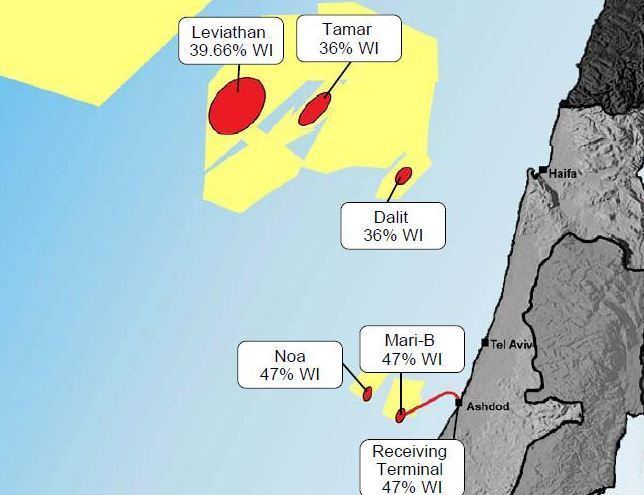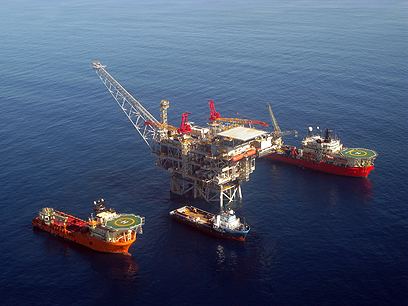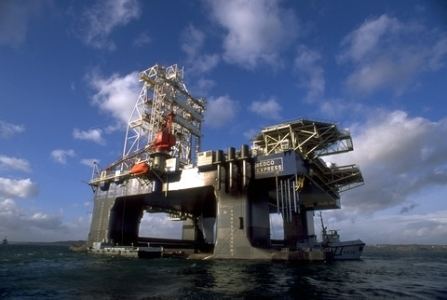Offshore/onshore offshore Discovery January 2009 Start of production 30 March 2013 | Block Matan licence Service contractors Aker Solutions | |
 | ||
Offshore israel tamar gas field in full production air robot security surveillance
The Tamar gas field is a natural gas field in the Mediterranean Sea off the coast of Israel. The field is located in Israel's exclusive economic zone (disputed), roughly 80 kilometres (50 mi) west of Haifa in waters 1,700 metres (5,600 ft) deep. The Tamar field is considered to have proven reserves of 200 billion cubic metres (7.1 trillion cubic feet) of natural gas, while the adjoining Tamar South field has 23 billion cubic metres (810 billion cubic feet). Together, they may have an additional 84 BCM of "probable" reserves and up to 49 BCM of "possible" reserves (reserves having a 10% probability of extraction). At the time of discovery, Tamar was the largest find of gas or oil in the Levant basin of the Eastern Mediterranean Sea and the largest discovery by Noble Energy. Since Tamar's discovery, large gas discoveries have been made in other analogous geological formations of the same age in the region. Because Tamar was the first such discovery, these gas containing formations have become collectively known as Tamar sands.
Contents
- Offshore israel tamar gas field in full production air robot security surveillance
- History
- Production
- Pipeline connection controversy
- Energy crisis and economic consequences
- Sheshinski Commission
- Monopoly Position of Tamar Partners
- Langotsky claims
- Maritime border with Lebanon
- Export plans
- References
History

In 1999, Israel's Oil Commissioner granted BG Group preliminary exploratory permits to deep-sea blocks that included the Tamar field. In December 2000, BG received an exploratory license, in a partnership that included three Israeli industrial companies, Mashav (15.6%, Dor Chemicals (7.2%), and Israel Petrochemical Enterprises (7.2%). In May, 2001, Mashav left the partnership and BG brought in STX, Isramco, Clal Industries, and Granit-Sonol, the latter two leaving the partnership in 2004.

In December 2001, BG completed 3D seismic studies that indicated the potential of the Tamar field and of the adjoining Dalit field. BG recommended drilling an exploratory well at an estimated cost of $40 million.

In May 2002, the BG license was extended by the Oil Commissioner, on the condition that drilling begin no later than September 2003. In February 2003, the Commissioner extended the deadline to December 2004, and in December 2004 a further extension was given to June 2005. During this period, BG conducted negotiations for selling gas to the Israel Electric Company.
In April 2005, BG announced that it was abandoning its stake. According to some reports, BG quit after being unable to conclude an agreement to supply gas to the Israel Electric Company. (Israel in mid-2005 reached an agreement to receive gas from Egypt for $2.75/mmbtu, a price that BG stated it was not willing to match.) In May 2005, the Oil Commissioner extended the license to December 2006 and allowed the remaining partners, STX, Isramco, Dor Exploration, and Dor Chemicals to bring in the Delek-owned partnerships, Avner and Delek Drilling, on the condition that a contract for drilling be concluded by June 2006. (According to one source, Avner bought its stake from BG for one dollar).
Noble Energy joined as operator in 2006. In 2006, the license was extended to December 31, 2008, despite the failure to begin drilling, and despite the statutory seven-year limit on oil licenses set by Israel's Oil Law. Isramco reported in 2006 that exploratory drilling was expected to cost $69 million.
Drilling of Tamar 1 began in November 2008. At the time, seismic studies indicated that there was a 35% chance that the formation contained gas.The studies further indicated that if there was gas, the median estimate for the producible quantity was 107 BCM.
Tamar 1 was drilled to a depth of 4,900 metres (16,100 ft) at a cost of $92 million. The partners announced the discovery on January 17, 2009. On July 7, 2009, the partners announced a second successful appraisal drilling at Tamar 2, increasing the estimated reserves of the field by 26%. In mid-2011, four more appraisal wells were drilled, with additional gas found at Tamar 3. In September 2011, Noble began production development.
In September 2010, Noble announced that development of the Tamar field was beginning at an expected cost of $3 billion. In March 2012 the Tamar partners signed a 15-year, US$14 billion deal with the Israel Electric Corporation to supply it with 42 billion cubic meters (BCM) of natural gas, with an option to increase the gas purchases up to $23 billion. By March 2012, the consortium developing Tamar had signed deals worth up to a total of $32 billion with six Israeli companies, committing up to 133BCM. According to a study commissioned by the government, the prices set were significantly higher than the price that would be demanded under comparable circumstances elsewhere.
Production
Production is carried out by five wells connected by a 93 mile long subsea double pipe tie-back to a gas processing platform located offshore Ashkelon. First commercial gas delivery took place on 1-April-2013 after four years of development work. The total initial delivery capacity is 985 MMCF per day or 10 BCM annually. Current contracts completely utilize this entire capacity. Therefore, an upgrade of the supply infrastructure from the processing rig to the onshore reception station in Ashdod is planned by 2016. In the first phase, capacity will be increased to approximately 1,200 MMCF/day and later to approximately 1,500 MMCF/day, with the latter upgrade possibly including the usage of the now-depleted Mari-B field, located nearby Tamar's processing platform, as a gas storage reservoir.
Pipeline connection controversy
On June 14, 2009, Shaul Tzemach, Director General of Israel's Energy and Water Resources Ministry, announced that the Ministry would rely on an analysis by Noble Energy to determine how pipelines from Tamar would connect to the national gas infrastructure. On September 22, Noble presented its analysis for connecting Tamar at a site on the Israeli coast, either adjacent to Moshav Ma'ayan Tzvi or 5 km farther north at Moshav Dor. Public controversy arose over the location of a plant to clean and process the gas from Tamar. Communities in the Carmel region brought a petition to Israel's High Court in March 2010, demanding that alternative sites be considered. In July 2010, the High Court issued an injunction that the Ministry explain its decision. In August, Uzi Landau, Minister of Energy and Water Resources, announced that the connection would be to Ashdod, a move that was expected to allow Noble to complete the project by the end of 2012, in line with the original deadline.
Energy crisis and economic consequences
The crisis in Egypt which began in 2011 led to sabotage of the pipeline in Sinai which supplied natural gas to Israel from Egypt. This, as well as declining production from the Israel Yam Tethys field, reduced the gas supplies to the Israel Electric Corporation and other large users, who turned to much more expensive liquid fuels until Tamar development was completed. The direct economic costs alone to the Israeli economy of the energy crisis have been estimated at NIS 20 billion.
Sheshinski Commission
Through 2009, Egypt increased the price of gas being sold to the Israel Electric Company, and the Israeli joint venture of Noble and Delek Energy, producing from the Yam Tethys field, followed suit. Higher prices enabled Yam Tethys profits for the third quarter of 2009 to reach new records, prompting several Knesset members to consider the need for revising the country's tax and royalty regime. On February 23, 2010, the Knesset Economics Committee held a session to discuss options for increasing taxes and royalties. During the session, committee member Carmel Shama stated that the government revenue from oil sales, as set in the Petroleum Law (1952), was relevant in an era when exploration risks were high and profits low, which was no longer the case in 2009. Gideon Tadmor, chairman of Delek Energy, claimed that changing the tax and royalty regime would freeze exploration and development.
On April 12, 2010, in response to the Knesset concerns, Israel's Treasury Minister Yuval Steinitz established a committee to consider the country's fiscal policy regarding its gas and oil resources. Eytan Sheshinski was appointed to head the committee. By the time the committee presented its findings in January, 2011, the Leviathan gas field had also been discovered.
The main recommendations of the committee included: 1) eliminating the tax allowance for "depreciation" of a field's value as its gas and oil was produced; 2) leaving the royalty rate unchanged at 12.5%; and 3) imposing a windfall profits levy, which would reach 50% of a producer's profits once the producer had recouped a certain percentage of his exploration and development costs. The windfall profits levy was incorporated into the Petroleum Profit Taxation Law, 5771-2011, which passed in March 2011. The law set the "recoup" percentage at 280% for the Tamar field and 200% for the Leviathan field and any field that would be developed later. State income from the windfall profits levy will be set aside in a sovereign wealth fund called the Israeli Citizens' Fund.
The owners of the Tamar and Leviathan licenses lobbied against the law, claiming that it represented a breach of contract and would scare off future investors in Israel; Uzi Landau, Minister of Energy, argued against applying the law to the Tamar field in particular, saying it would delay the field's development. Nevertheless, when Tamar production began on schedule in April 2013, both Landau and Noble CEO Charlie Davidson claimed that the project had been completed in record time.
Monopoly Position of Tamar Partners
In January 2011, as the Knesset was debating the Profit Taxation Law, the Egyptian Revolution of 2011 began. Within weeks, the Egyptian-Israeli gas pipeline had been sabotaged, and in April the former Egyptian petroleum minister had been arrested for alleged corruption related to the sale of gas to Israel. The cessation of gas from Egypt meant that the Tamar project would come on-line as the sole gas supplier to Israel. By the end of 2011, the Tamar group had raised the price of gas in its contract with IEC, effectively restoring to the partners most or all of the profit that they had expected before the passage of the Profit Taxation Law.
In May 2011, Energy Minister Uzi Landau instructed the pricing commission of the ministry to evaluate regulating the price of gas. In May, 2012, the commission published its conclusion that gas should be a regulated commodity and that the commission would monitor contracts to determine whether prices were fair. A study sponsored by the commission showed that the Tamar partners annual after-tax returns could be expected to be 54% of assets, as opposed to the 19% annual return projected by the Sheshinski Committee. In February 2014, Knesset Member Shelly Yachimovich issued an open letter to the government, berating it for not setting fair gas prices that could reduce the country's cost of living.
Langotsky claims
An early promoter of the project was Israeli oil geologist Joseph Langotsky, who named the Tamar and Dalit fields after his daughter and granddaughter. Langotsky had a small share of STX, a limited partnership that had a small share of the Tamar license from 2001 through 2008. The primary owner of STX was Israeli businessman Benny Steinmetz. Langotsky sued Steinmetz after the Tamar discovery in 2010, claiming that Steinmetz dropped out of the partnership two months before drilling began, causing Langotsky to lose his rights to the field. In July 2013 the court ruled in Langotsky's favor, ordering Steinmetz to pay Langotsky NIS 50 million (appx. US$14 million) in compensation.
Maritime border with Lebanon
Following the discovery in 2009, some Lebanese leaders, particularly officials of the Lebanese Shi'a Islamist group Hizbullah made statements threatening Israel against developing the sites, and Israeli officials made counter threats against Lebanese intervention. In August 2010, the issue was largely resolved when Lebanon submitted to the United Nations its official view regarding the maritime border, indicating that it considered the Tamar and Leviathan gas fields to be outside Lebanese territory (though it indicated other prospective fields in the region may be within Lebanese territory). The US expressed support for the Lebanon proposal.
Export plans
Delek Energy held talks on exporting natural gas from Tamar to Cyprus and to South Korea. Shipments to Asia would be by Liquified Natural Gas, for which a floating liquefied natural gas terminal would be built by Daewoo Shipbuilding & Marine Engineering, with Front-end engineering of the terminal to be done by Höegh LNG. In March, 2013, Israeli Minister of Energy, Uzi Landau issued a notice to the Tamar partners not to proceed with signing export contracts until it is granted permission to do so by the Israeli government.
